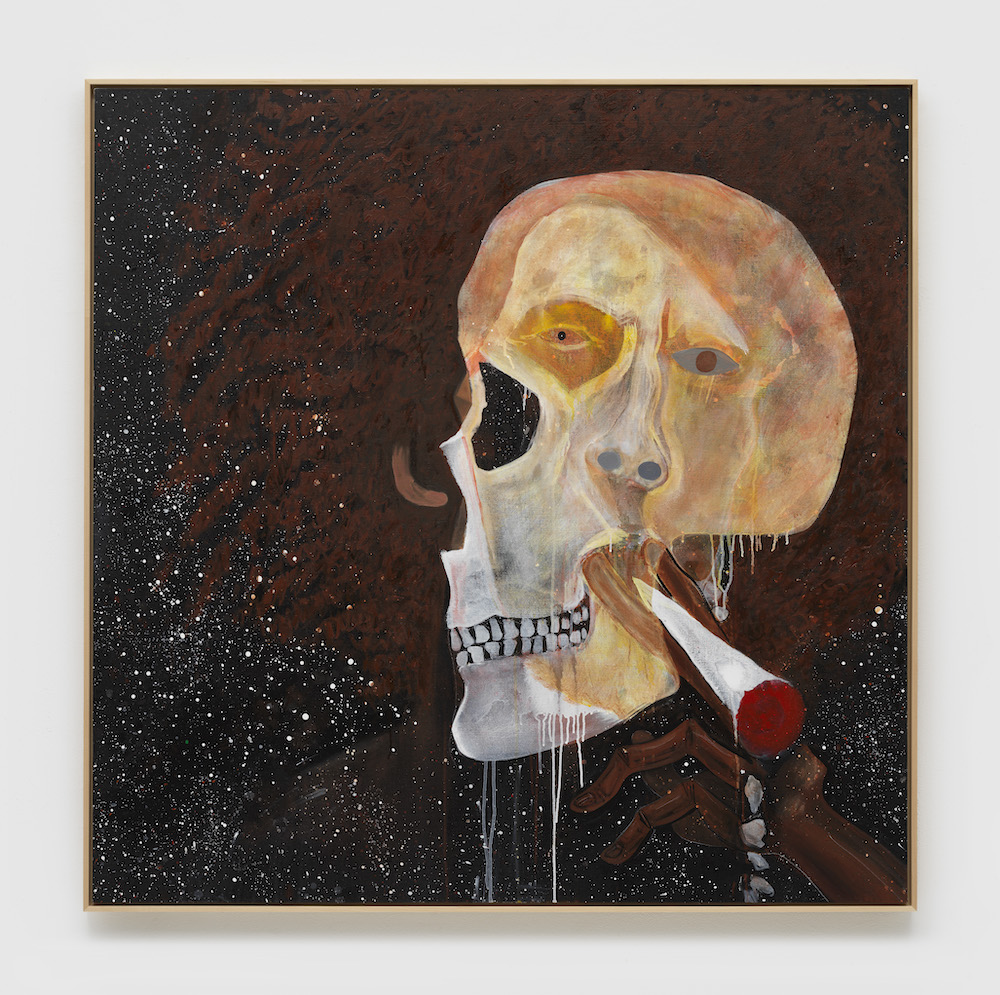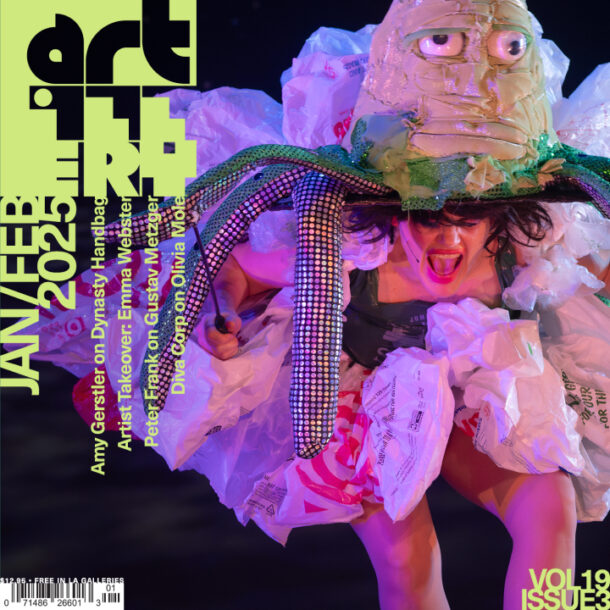The flattening of high and lowbrow imagery is certainly not new, indeed the painter Jason Fox has been mining this territory since the early 1990s. In his current show at David Kordansky Gallery, “Why Are You Sitting in the Dark?,” Fox refines his enigmatic juxtapositions of pop culture, music, comics, art history, and autobiography, relying on a series of oft-repeated images as tools for formal experimentation.
Well-known images of popular musicians of the late 1960s and 70s appear like a refrain throughout the show, as Fox returns again and again to icons of the period, George Harrison, Joni Mitchell, and Bob Marley. In interviews, the artist has spoken about the failure of the utopian promise of the 60s, and these images are suffused with a sinister or haunting quality that reminds us that, as Altamont followed Woodstock, free love communes began the Manson family. In the painting that gives the exhibition its title, Mitchell sits on a green couch, her figure overlaid with a transparent goat figure and a gargoyle, its wings unfurled. The press release states that the goat is “Goya-inspired,” but it also recalls Baphomet, the goat-headed demonic incarnation. In Demigod (2024), Fox zooms in on Mitchell’s head, here resembling a flaxen-haired Gregg Allman, and the goat, whose enlarged eye glares at us with hypnotic intensity.
Harrison is depicted in his shaggy, bearded persona, resembling both Jesus and Charles Manson. In a vibrant yellow-orange canvas, Untitled (2024), and a variation in green, Afternoon (2024), his face is obscured by Fox’s melancholic dog. Fox repeats an image of Marley smoking a large spliff, taken from his 1973 album “Catch a Fire”, across three paintings and four drawings in the show, often with a vanitas-like skull hovering atop it. In Sailing (2024), Marley’s eyes gaze out from behind the bright diaphanous yellow skull, while with Light Years (2023), a more opaque white skull takes prominence, accentuated by Marley’s wild mane of brown hair, and the gleaming red cherry of the spliff. They recall Max Beckmann’s self-portraits, in which the German Expressionist portrays himself with his ubiquitous cigarette, channeling Beckmann’s sense of modernist alienation through the reggae star.

Jason Fox, Light Years, 2023. Courtesy of the artist and David Kordansky Gallery.
Fox pulls from other art historical references, combining them with his pop-cultural touchstones. “I wanted to blow the figure up and rebuild it in a Frankensteinish way,” Fox said in an interview with Joe Bradley published in a 2017 CANADA catalogue. “Art history and comics were the body parts.” Fox bears out this impulse in After Midnight (2024), a large, red portrait of Homer Simpson, superimposed with a wolf-like figure, that is one of the strongest—and strangest—works in the show. Guston is a clear influence on the artist—“the big shadow to get out from under,” he told Bradley—a kindred spirit who vacillated between high modernism and cartoon pulp. The connection is evident in details like the dotted line of canvas stitching in the background, and the Santa boots on Simpson’s feet.
The show’s most successful works balance these elements in ways that are confounding thematically and visually, sandwiching wafer-thin translucent layers in the shallowest of suggested space. Works like C’mon Everybody (2025), which features a monstrous troubadour strumming a guitar, are lively, but lack the tension of his more engaging paintings, edging into Robert Nava-esque doodling. The sole sculpture Willie (2022), a portrait of country singer Willie Nelson, composed of a thick wooden cross with braids and a bandana, is an amusing send-up of minimalism, but essentially a one-liner.
In the same room as the sculpture are several drawings that offer insights into Fox’s iterative process, evidence of creative diligence rather than (just) basement stoner bro-ism. Fox is not the first artist to merge modernism with pop culture, formalism with low-brow tropes, but few artists do it with such pathos, relatability, and depth.


